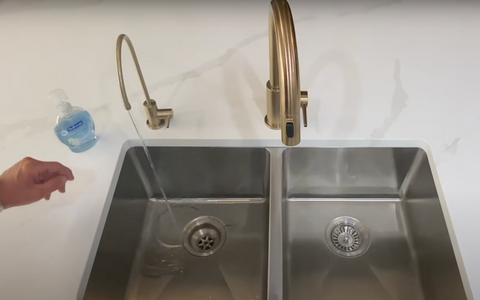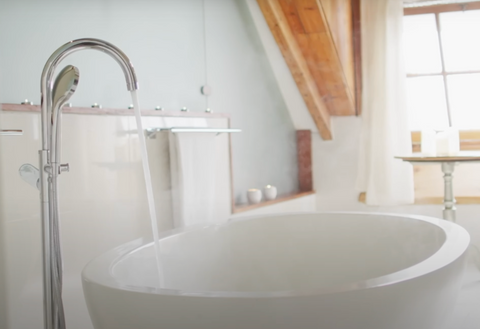Hey, I'm Gary, your trusted Water Guy, here to simplify water filtration and empower you to conquer those pesky water problems! Today we're going to debunk some common misconceptions surrounding reverse osmosis drinking water systems.
Get ready for some eye-opening revelations as we dive into the truth behind Reverse Osmosis (RO) systems. Discover how reverse osmosis can provide your family with super-pure drinking water that surpasses all expectations. Say goodbye to myths and hello to crystal-clear, refreshing water for your home.
Here’s the straight talk about Reverse Osmosis myths and how RO systems will give you super pure drinking water for your family. Be sure you cheque out ALL of the myths because many of them will surprise you, especially that last one!
1. Reverse osmosis water is unhealthy to drink.

Some people think Reverse Osmosis or RO removes all of the good minerals from your water. Actually, 95% of the minerals we need in our diet come from the food we eat, not water. Take calcium for example, an 8-ounce glass of orange juice will give you 30% of your recommended daily amount whereas you would need to drink a bathtub full of water to get a similar amount.
So, the best way to reach your mineral intake goals is to eat a balanced diet and drink clean, pure reverse osmosis water. Water hydrates our bodies and is essential for proper organ function — but the vitamins, minerals and organic compounds we need to lead healthy lives come from the foods we eat, not the water we drink.
2. Tap water is just as good as reverse osmosis water.

Water treatment plants, just like everything, have only so much money for water filtration. For every contaminant present in water, there is an ideal level of contamination and there is a realistic level that mass treatment can yield.
Lead, for example, is dangerous to consume at any level of concentration. However, to completely eliminate lead, city water treatment plants would need to spend far more money than they have, so the EPA must set realistic standards that are a compromise. Since lead cannot be completely eradicated during municipal water treatment, the EPA standard for lead in drinking water is 15 parts per billion. While this may seem like an inconsequential amount of lead, it can lead to long-term health effects, especially in pregnant women and young children.
Municipal Water Filtration systems do nothing to remove salt, Forever Chemicals like PFAS, fluoride, arsenic, VOC, TDS. Those water filtration processes actually ADD chlorine and chloramines to your drinking water.
Installing an RO system will not only make your water taste better, but it will also reduce levels of all of those contaminants, that can compromise the long-term health of your family.
3. Bottled water is better than reverse osmosis water.

Not only is the quality of reverse osmosis just as good, if not better, than bottled water, it’s much more environmentally friendly, too.
In fact, many brands of bottled water use Reverse Osmosis as their filtration process. The differing tastes of bottled water brands rely on either the spring water they use or the minerals, often salt, added back to the water after Reverse Osmosis filtration. Since Reverse Osmosis uses the same filtration process as many bottled water brands, a home reverse osmosis system can produce RO water that tastes just as good as bottled water.
From an environmental perspective, home RO systems do not produce nearly the amount of plastic waste that water bottles do. Around 60 million water bottles are wasted in the U.S. every day, leaving behind a massive carbon footprint. Of those 60 million, about 12 percent are actually recycled. Even the plastic that is recycled cannot be reused in applications like food packaging.
Reverse osmosis systems help massively reduce plastic usage in cities every year and, since they cost little to maintain, are much more cost-effective than bottled water, AND let’s not forget about that carbon footprint of shipping those premium waters from the French Alps and other exotic locations.
4. Reverse Osmosis filters are expensive.
While Reverse Osmosis systems are not inexpensive, they’re much cheaper and more eco-friendly than relying on bottled water. Under-sink RO systems, which are recommended over whole-home systems, range from $350 to $1000. In contrast, a single person can expect to spend about $1000 on water bottles annually.
While Replacement Filters must be purchased annually, their total cost for a non-proprietary system like this is about $60.
5. The Reverse Osmosis purification process is wasteful.

While Reverse Osmosis systems must flush the impurities to the drain during the filtration process, their efficiency has improved drastically in the past couple of decades. The term wasteful is misleading because reverse osmosis systems utilize the “wasted” water for flushing the membrane rather than just dispensing it to the drain.
When you take a shower, clean your dishes or wash your clothes, you do not consider the water you use in those processes to be wasted, do you? Rather, you used it to benefit the health and well-being of your family. The same can be said for reverse osmosis systems. To appropriately filter water for consumption, some water must be used to carry contaminants away from the system.
A high-efficiency Reverse Osmosis drinking water system like this one flushes about 1 ½ gallons of water for every gallon of filtered water that your family drinks.
6. Refrigerator filters are just as good as reverse osmosis filters.
Refrigerator filters are a great start for enhancing the taste of city water because they remove chlorine to improve the taste.
Reverse osmosis systems feature four to five stages of water filtration: a sediment/carbon prefilter, a reverse osmosis membrane, and an activated carbon postfilter. Not only will Reverse Osmosis systems reduce chlorine and chloramine levels, but they also reduce total dissolved solids, salts, sediment, arsenic, volatile organic compounds, fluoride, chloramines and many other Forever Chemicals like PFAS.
Refrigerator filters will enhance the taste of your water, but they won’t remove any of these contaminants.
7. You can use a water softener instead.

A water softener is not meant to make water healthier to drink. Hard water is not unhealthy to consume, but it can wreak havoc on its way to your faucet.
An RO filter, on the other hand, is designed to make water safe and healthier for your family. Although RO does remove hardness minerals, it also removes contaminants, such as lead and arsenic, that cause bodily harm over time.
As a result, a water softener cannot be used as a replacement for a reverse osmosis system. However, if you live in a region with hard water, a water softener is recommended to maintain the health of you, your RO system, appliances, plumbing, skin and hair.
8. RO water is too acidic.
RO water has a pH of about 6.0. Your stomach pH is 1.5 to 3.5. At the stage where water enters your stomach, the pH of the water doesn’t matter at all because the stomach is so much more acidic. What does matter is that the contaminants that you are ingesting like fluoride, potentially lead, PFAS, salt and the rest have been significantly reduced.
If you want to increase the pH of your RO water, you can always add a calcite filter to add some calcium back in.
9. Alkaline water is better.

Alkaline water is water with a higher pH than 7.0, which is how we measure the acidity of water. But according to the Mayo clinic, "research suggests that alkaline water is unlikely to significantly change blood pH. Some studies suggest that alkaline water might help slow bone loss, but it's not clear if the benefit is maintained over the long term. Some say that alkaline water can help prevent diseases, such as cancer and heart disease. However, there's little credible evidence to support such claims”.
10. You don’t need RO water, tap water is safe to drink.
Families in Flint, Michigan - Walkerton, Ontario – Parkersburg, West Virginia and numerous more cities across North America would disagree. Reverse Osmosis removes lead and countless other contaminants from drinking water and provides a second barrier from bacteria.
11. RO water will leach minerals out of the body.
There is absolutely no research to support this. RO pulling minerals out of the body is totally unsubstantiated. Since rainwater and surface water are also low in mineral content do you think that mankind's anticipated water source would have these characteristics? Also, keep in mind that in Vancouver, BC, Canada their municipal drinking water converts to a TDS range of approximately eight to 20 mg/L, which is the same or lower than most POU RO Systems. We would certainly know if there were health effects from low TDS water on the 600,000 people in that city.
RO Myths Busted
I hope this blog has shed light on the truth behind some of the main RO myths out there, and provided you with valuable insights into the benefits of RO systems for your family's hydration needs.
Reverse Osmosis water is not only safe to drink it is extremely healthy for your family. You need to ask yourself: would you rather drink water with potential contaminants like PFAS, lead, bacteria, chromium 6, arsenic, nitrates, chloramines and PPCP’s to get 5% of the minerals you need knowing that water is not a major source for your daily mineral intake, the foods you eat are?
OR would you prefer to drink super pure, great tasting, contaminant-free Reverse Osmosis water and choose to eat the right foods to get the minerals you need? The answer is clear to me and my family. I'm guessing you feel the same!
>> SHOP REVERSE OSMOSIS SYSTEMS





